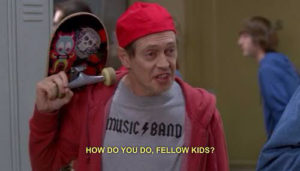The Kids Are Alright: Connecting to the Youth Online
Ah, the joys of youth – growing pains – remember swooning over your first crush from a folding desk? Sorting through your college picks with staggering anxiety, breaking curfew to spend time with your friends, and taking powerful life lessons from Lysol’s most recent ad campaign? Wait, was that just me?
All right, adolescence and the transition into early adulthood are a confusing and vulnerable time. Wisdom and maturity come to us from all sorts of places, and young people are always looking for a voice out there that understands them. That doesn’t mean that they aren’t discerning about the people and things they choose to relate to.
Reaching Out
Teenagers and young adults have been a prime target of marketing campaigns for several decades. The combination of supplemental income from parental and financial aid, alongside a burning desire to develop a personal identity, means that a lot of their purchases are directed by emotion. Image and branding mean a lot to them. Marketing works. It’s no surprise, then, that sales and marketing teams look for ways to connect.
Catastrophically
The problem is that a lot of these efforts are ill-informed and ill-advised. DiGiorno once used #WhyIStayed (“You had pizza”) to promote their product on twitter, which would have been fine, if not for the fact that the WhyIStayed hashtag is used for the confessions of abuse victims … yikes!
Another example of a flop appeared when Bagel Bites attempted to use the “here come dat boi” meme, an image of a frog on a unicycle, to promote their snack. The problem is that unlike other internet memes that are get repurposed with slight permutations, “here come dat boi” was a sort of stand-alone non sequitur that did its rounds on internet boards. While the image wasn’t egregiously insensitive like DiGiorno’s effort, it nonetheless fell flat on its audience and became an inside joke of a failed marketing effort on certain internet boards.
Know Your Meme
As it would be, the internet can be a hostile landscape. Inclusivity is not a hallmark of many online communities. Whether you’re an individual user or a team, there’s a lot of competition for attention out there and things can turn dark quickly.
In previous blog entries, we’ve discussed the debatable merit of social media campaigns as a whole. It’s also worth considering what a lot of internet culture revolves around in general. When ARPANET was taking its baby steps and TCP/IP protocol was getting ready to make its leap into civilian life, cyberspace was envisioned as a meeting place of minds – a wondrous landscape, free from the constraints of the corporeal world, where human beings could communicate, innovate, and perhaps even make the transition into a new advanced form of sentience. As it would be, it became a place where we yell at people we disagree with while sharing cat pictures and shopping for sneaker deals on Amazon. Irony, self-deprecation, call-out culture, and schadenfreude define a tremendous amount of online exchange and pretty much the entirety of meme culture. It’s important to consider whether your brand image is compatible with all that.
Do It Right
If you do feel that your branding could benefit from an edgier online presence that speaks to young people, there are some basic guidelines that should steer your efforts.
- Know Your Product: So about life lessons from Lysol… it’s not going to happen. It’s true that a lot of marketing is about spin. The right team can take a mundane product and turn it into something provocative, playfully transgressive, or fun, but there are limits. Consider your consumer base and just how realistic it is to cast a broad net.
- Don’t Try Too Hard: There may be a perfect opportunity in one of your campaigns to throw in a reference or mix it up. Maybe your promotion makes sense in the context of a viral phenomenon, or maybe a tweet warrants a reply that’s edgy and current. Keep it subtle and well-timed. If you have a social media manager who “gets it,” give him or her some space to make it work without pressuring a voice.
- Have Fun: At the end of the day, you’re trying to get a smile, and it shows when you’re sharing a laugh instead of begging for one. Good marketing is about empathy. You have to understand your audience and what they appreciate. It always works best when you’re inviting people to enjoy things together.
Mehran is a copywriter, editor and tech savvy internet guy at Words by a Pro.

